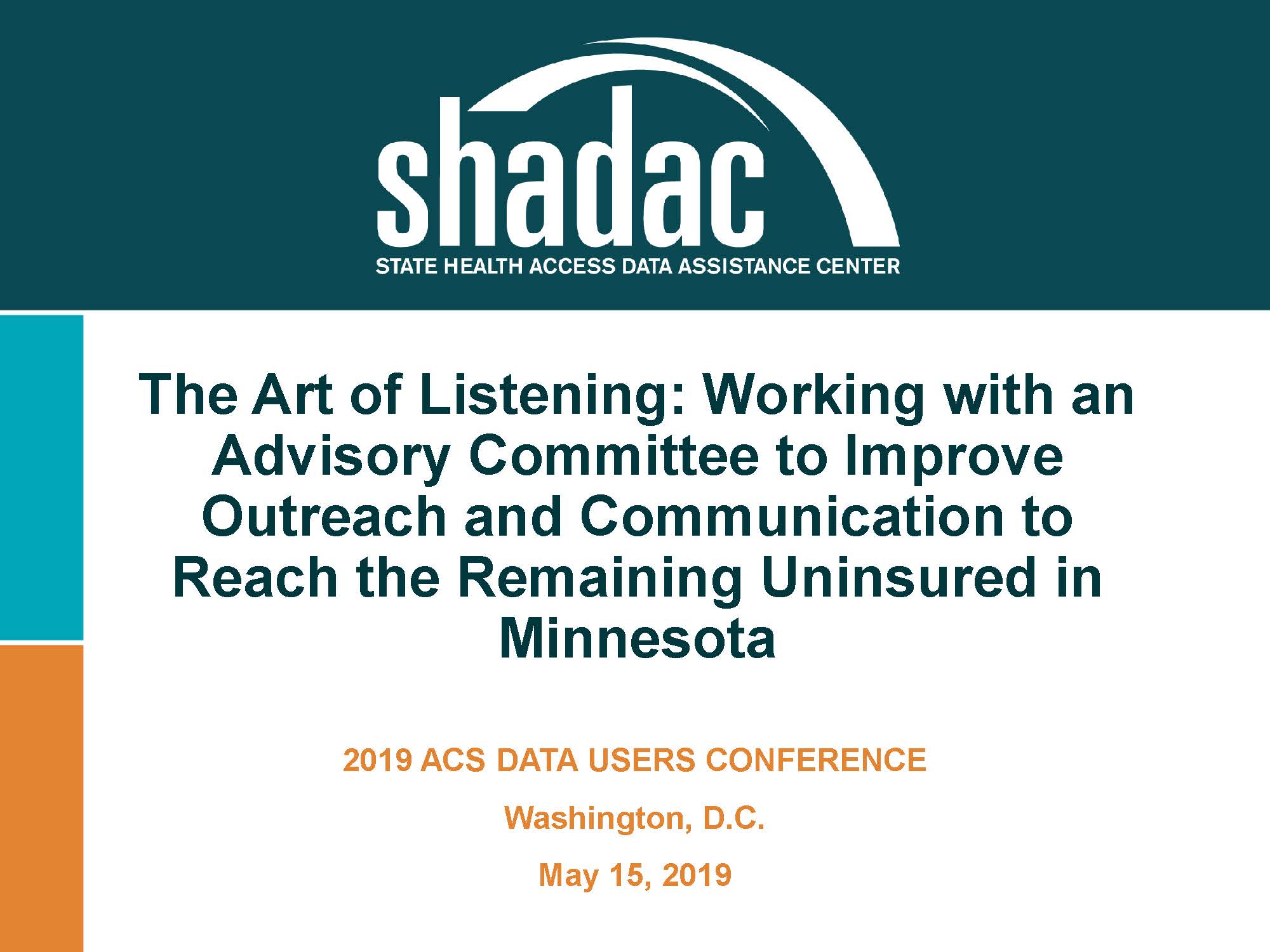Blog & News
SHADAC Senior Research Fellow Brett Fried Serves as Expert at Census Convening
July 3, 2019:Expert Meeting on Changes to the Current Population Survey Annual Social and Economic Supplement (CPS ASEC)
SHADAC researcher Brett Fried served as a discussant at the Expert Meeting on Changes to the CPS ASEC, held in Suitland, Maryland on May 13, 2019. The U.S. Census Bureau convened this meeting to discuss the implications of the new data processing system implemented in the 2017 CPS ASEC Research File and gather feedback from key stakeholders.
The new processing system addresses changes made to the income and health insurance questions in the 2014 CPS ASEC and changes in the 2015 CPS ASEC that allow spouses and unmarried partners to identify as opposite- or same-sex.1,2,3 Further details on the new system and differences in health insurance estimates between the 2017 Research File and the 2017 Production File were recently published in a series of working papers by the Census.
For the May Expert meeting, Brett provided commentary on the health insurance portion of the Census presentations, placing the findings into the context of historical work performed by SHADAC in evaluating health insurance estimates in the CPS ASEC.
The invitation by the Census Bureau to present at this meeting continues a long tradition of partnering with SHADAC and other outside researchers to evaluate the impacts of changes to CPS processing systems and survey questions. Examples of SHADAC’s contribution to this work include a 2011 paper examining modifications of the imputation routine in the CPS ASEC4 and SHADAC’s current work with Census on measurement error in health insurance coverage in the CPS ASEC and the ACS.5,6 SHADAC is also currently working on two briefs that will address differences at the state level, and those will be available in late summer or early fall.
2019 American Community Survey (ACS) Data Users Conference
 Brett Fried was also recently invited to present at the 2019 American Community Survey (ACS) Data Users Conference, held in Washington D.C. on May 15, 2019. He shared lessons learned from a SHADAC project, funded by the Blue Cross Blue Shield MN Foundation, that used American Community Survey (ACS) data to support outreach and enrollment for Minnesota’s uninsured.7 Specifically, he spoke about the ways in which working with an advisory committee helped change the focus, geographic level, and usefulness of the project.
Brett Fried was also recently invited to present at the 2019 American Community Survey (ACS) Data Users Conference, held in Washington D.C. on May 15, 2019. He shared lessons learned from a SHADAC project, funded by the Blue Cross Blue Shield MN Foundation, that used American Community Survey (ACS) data to support outreach and enrollment for Minnesota’s uninsured.7 Specifically, he spoke about the ways in which working with an advisory committee helped change the focus, geographic level, and usefulness of the project.
Among the many other presentations at the conference, three generated particularly high levels of interest. Census researcher Rolando Rodríguez presented on the Census Bureau’s new approach to data privacy, highlighting the concern that current ACS disclosure avoidance practices are not adequate and that more formal privacy methods, informed by those used for the 2020 Decennial census, will be needed.8 This could have potential implications for comparability of estimates across years, availability of public use files, and availability of estimates for small areas.
Census researcher Zach Whitman discussed the Census Bureau’s new data dissemination platform, data.census.gov, noting that no new data will be included in the American FactFinder as of June 2019 and legacy American FactFinder data will be transitioned to the new platform by June 2020.9 Users are encouraged to use the tool and provide feedback to the Census Bureau.
Constance Citro from the National Academies of Sciences provided commentary on the two presentations, noting that both were “excellent and thought provoking” talks. However, she was concerned that it was not enough to just invite input from users, but rather “two-way user interaction” is needed instead. She then outlined steps that the Census Bureau could take to “ensure that new privacy protection techniques and the new platform are implemented with full consideration of alternatives and user needs.”10
Finally, individuals from the Census Bureau responded in a plenary session to concerns about the potential impact of including a citizenship question on the 2020 Decennial Census by discussing an analysis they were conducting to estimate the effect on response rates. This paper, “Predicting the Effect of Adding a Citizenship Question,” is now available. The authors estimate that adding a citizenship question would result in an 8 percentage point drop in the response rate for households that have at least one non-citizen as compared to households with only citizens.11
For further details, a YouTube video of these presentations and responses to questions from conference participants is available for viewing, and copies of the presentations are available to download here.
Notes
1 Jackson, H.M. (2019, April 17). Uninsurance estimates from the redesigned Current Population Survey: An examination of the imputation process [SEHSD Working paper: 2019-20]. Retrieved from https://www.census.gov/topics/health/health-insurance/library/working-papers.html
2 Berchick, E.R., & Jackson, H.M. (2019, January 23). Health insurance coverage in the 2017 CPS ASEC research file: Estimates from the research file [SEHSD Working paper: 2019-02]. Retrieved from https://www.census.gov/topics/health/health-insurance/library/working-papers.html
3 Berchick, E.R., & Jackson, H.M. (2019, January 23). Health insurance coverage in the 2017 CPS ASEC research file [SEHSD Working paper: 2019-01]. Retrieved from https://www.census.gov/topics/health/health-insurance/library/working-papers.html
4 Boudreaux, M., & Turner, J. (December 2011). Modifications to the imputation routine for health insurance in the CPS ASEC: Description and evaluation [State Health Access Data Assistance Center Working paper]. Retrieved from https://www.shadac.org/sites/default/files/publications/CPS_Imputation_Dec2011.pdf
5 Pascale, J., Fertig, A., & Call, K.T. (Forthcoming). Assessing the Accuracy of Survey Reports of Health Insurance Coverage Using Enrollment Data. Health Services Research.
6 Pascale, J., Fertig, A., & Call K.T. (June 2019). Validation of Two Federal Health Insurance Survey Modules After Affordable Care Act Implementation. Journal of Official Statistics, 35(2), 409-460. http://dx.doi.org/10.2478/JOS-2019-0019
7 Fried, B., Call, K.T, Lukanen, E., Pando, C., & Turner, K. (2019, May 15). The art of listening: Working with an advisory committee to improve outreach and communication to reach the remaining uninsured in Minnesota [PowerPoint slides]. Retrieved from https://www.shadac.org/publications/art-listening-working-advisory-committee-improve-outreach-and-communication-reach
8 Rodríguez, R.A. & Lauger, A.D. (2019, May 15). Proceedings from the ACS Data Users Conference: Innovating data privacy for the American Community Survey. U.S. Census Bureau, Center for Enterprise Dissemination–Disclosure Avoidance.
9 Whitman, Z. (2019, May 15). Proceedings from the ACS Data Users Conference: Vision and future plans for the Census Bureau’s data dissemination platform. U.S. Census Bureau, Center for Enterprise Dissemination Services and Consumer Innovation.
10Citro, C.F. (2019, May 15). Proceedings from the ACS Data Users Conference: Dissemination of ACS data: Looking ahead—discussion. Committee on National Statistics, National Academies of Sciences, Engineering, and Medicine. ACS Data Users Conference; May 15, 2019.
11 Brown, J.D., Heggeness, M.L., Dorinski, S.M., Warren, L., & Yi, M. (2019). Predicting the effect of adding a citizenship question to the 2020 Census [Working papers 19-18]. Retrieved from https://ideas.repec.org/p/cen/wpaper/19-18.html









